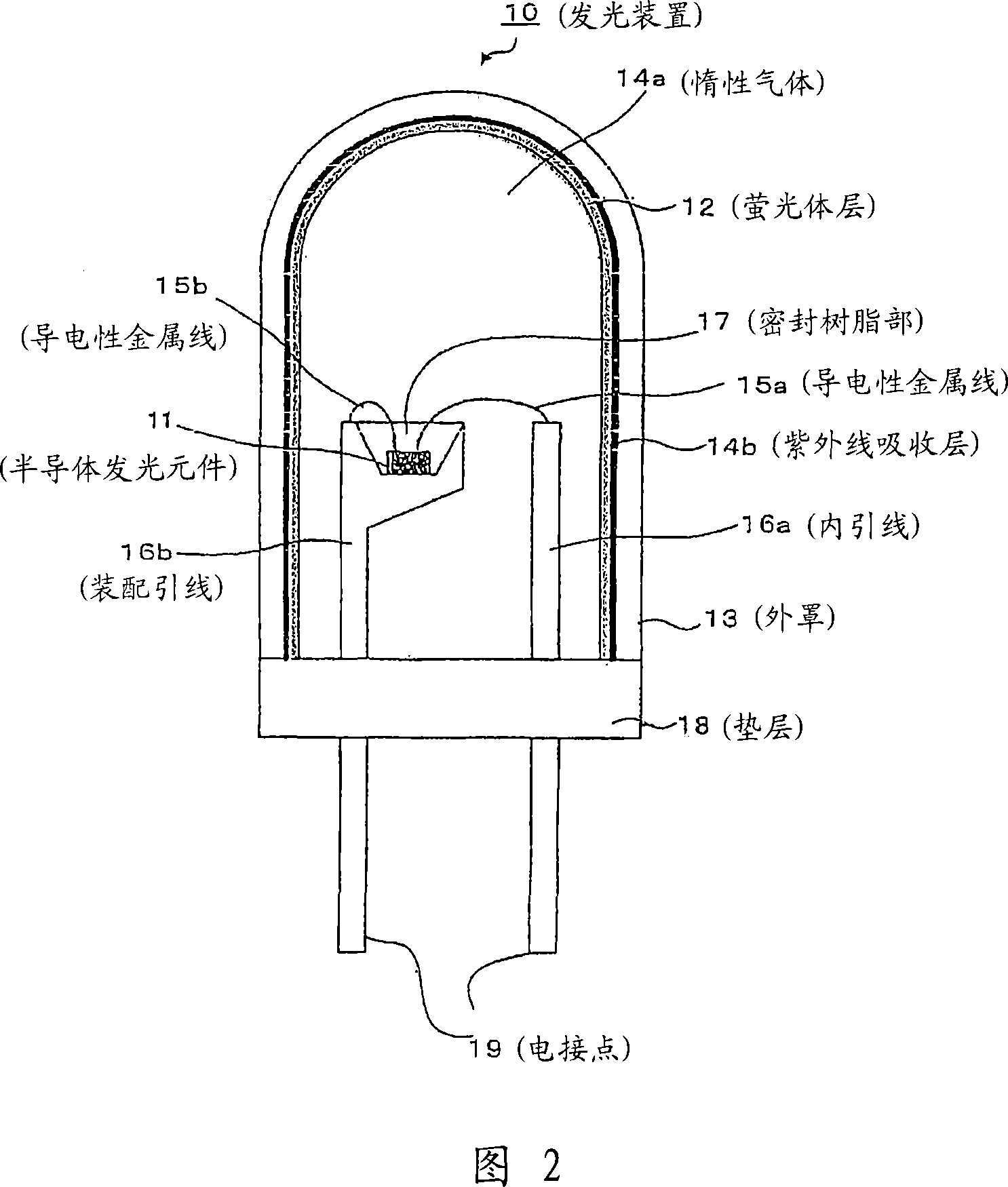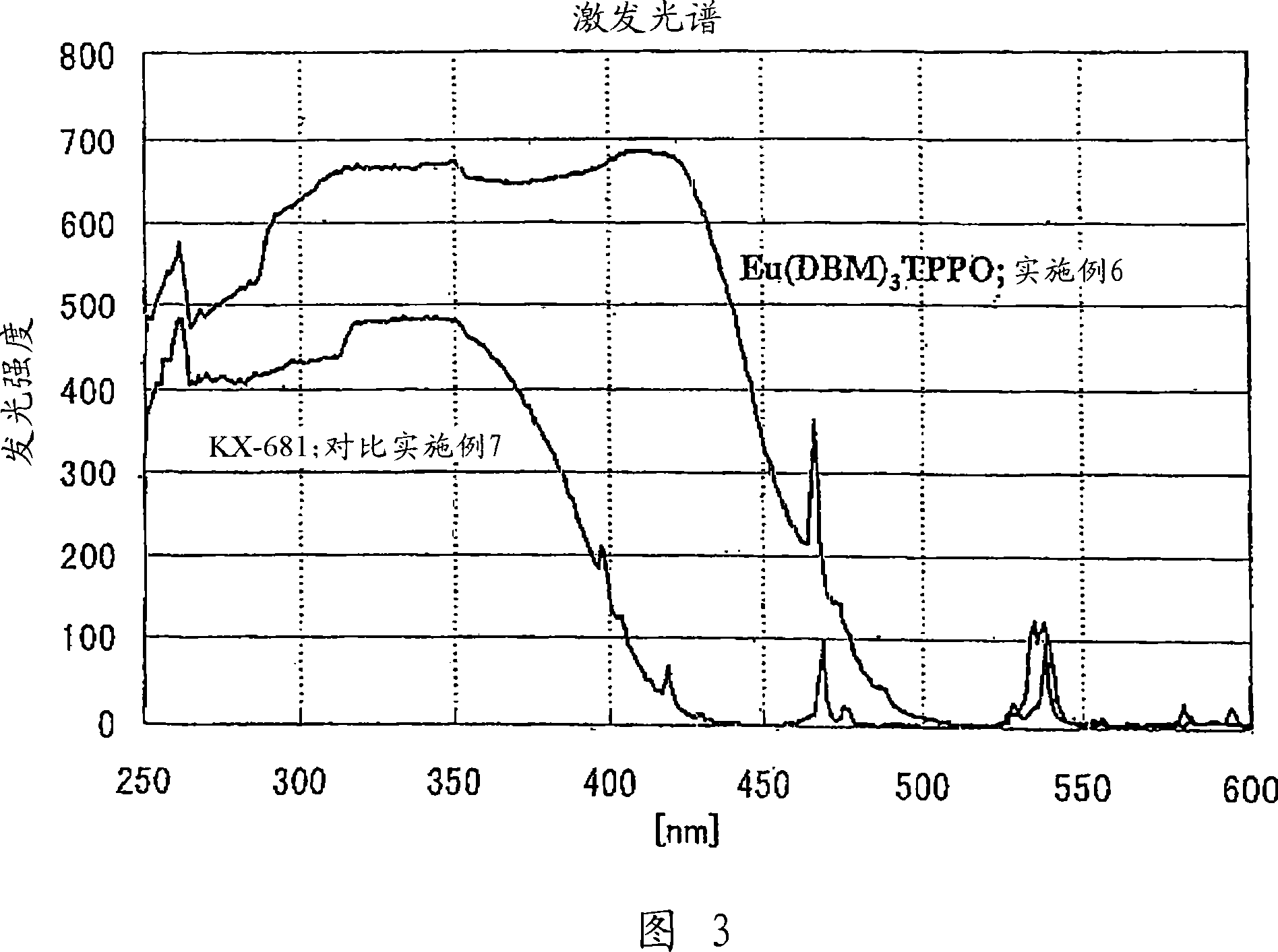Light emitting device, and lighting device and image display unit using it
A light-emitting device and light-emitting element technology, which is applied in the field of lighting devices, image display devices, and light-emitting devices, can solve problems such as insufficient luminous intensity, and achieve the effect of high luminous intensity
- Summary
- Abstract
- Description
- Claims
- Application Information
AI Technical Summary
Problems solved by technology
Method used
Image
Examples
Embodiment 1
[0098] Eu(TTA) 3 (TPPO) 2 Synthesis
[0099] Dissolve 0.67g (3.0mmol) of 4,4,4-trifluoro-1-(2-thienyl)-1,3-butanedione (H-TTA), 0.56g (2.0 mmol) of triphenylphosphine oxide (TPPO) and 0.32 g (3.0 mmol) of 2,2'-iminodiethanol. Utilize 2 hours at room temperature to this solution, add dropwise to this solution by dissolving the mixed solvent of 0.37g (1mmol) of europium(III) chloride hexahydrate in 20ml of water / isopropanol (1 / 4) The resulting solution was stirred continuously at room temperature for 1 hour. The resulting precipitate was suction filtered and washed with water and isopropanol. The obtained light yellow powder was dried in vacuum at 50°C to obtain the target product Eu(TTA) represented by the following structural formula 3 (TPPO) 2 . The complex has a melting point of 248°C to 251°C.
[0100]
Embodiment 2
[0102] Eu(TTA) 3 Synthesis of Phen
[0103] Dissolve 6.67g (30mmol) of H-TTA, 1.98g (10mmol) of 1,10-phenanthroline (Phen) monohydrate and 3.16g (30mmol) of 2,2'-iminobis in 500ml of ethanol ethanol. To this solution was added dropwise a solution obtained by dissolving 3.67 g (10 mmol) of europium(III) chloride hexahydrate in 200 ml of ethanol at room temperature over 4 hours, followed by standing at room temperature for several hours . The precipitate formed was then filtered off with suction and washed with ethanol. The obtained pale yellow powder was dried in vacuum at 50° C. to obtain the target product Eu(TTA) represented by the following structural formula 3 Phen.
[0104] Elemental analysis of this complex showed 43.33% C, 2.36% H, and 2.78% N, which is approximately equal to the calculated values of 43.43% C, 2.02% H, and 2.81% N. Also, the melting point of this complex is 242°C to 243°C.
[0105] For the obtained Eu(TTA) 3 Phen complexes were determined by p...
Embodiment 3
[0111] Eu(TTA) 3 Synthesis of IQNO
[0112] In 25 ml of ethanol were dissolved 0.67 g (3 mmol) of H-TTA, 0.15 g (1 mmol) of isoquinoline-N-oxide (IQNO) and 0.32 g (3 mmol) of 2,2'-iminodiethanol. To this solution at room temperature, a solution obtained by dissolving 0.37 g (10 mmol) of europium(III) chloride hexahydrate in 20 ml of ethanol was added dropwise to this solution, then 15 ml of water was added, followed by Keep stirring for several hours. The precipitate obtained was filtered off with suction and washed with water. The obtained light yellow powder was dried in vacuum at 50°C to obtain the target product Eu(TTA) represented by the following structural formula 3 IQNO. The complex has a melting point of 249° to 251°C.
[0113]
PUM
| Property | Measurement | Unit |
|---|---|---|
| melting point | aaaaa | aaaaa |
| melting point | aaaaa | aaaaa |
| melting point | aaaaa | aaaaa |
Abstract
Description
Claims
Application Information
 Login to View More
Login to View More - R&D Engineer
- R&D Manager
- IP Professional
- Industry Leading Data Capabilities
- Powerful AI technology
- Patent DNA Extraction
Browse by: Latest US Patents, China's latest patents, Technical Efficacy Thesaurus, Application Domain, Technology Topic, Popular Technical Reports.
© 2024 PatSnap. All rights reserved.Legal|Privacy policy|Modern Slavery Act Transparency Statement|Sitemap|About US| Contact US: help@patsnap.com










